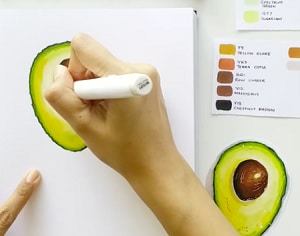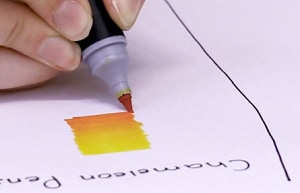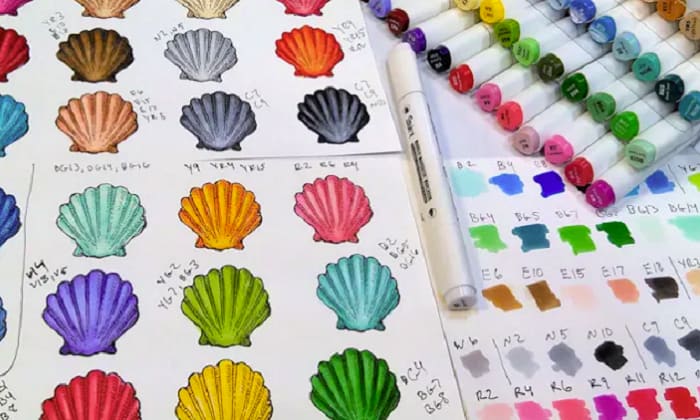Alcohol markers are most preferred by artists because of their wide range of vibrant colors, flexibility, and blendability. Due to these characteristics, these markers allow for many layering techniques and smooth transitions.
Fortunately, blending alcohol markers is not that complicated when you learn the basics. In this article, we will introduce multiple ways how to blend alcohol markers, and a variety of other alcohol marker tutorial.
Table of Contents
Ways to Blend and Color With Alcohol Markers
In order to blend alcohol markers properly, you’ll first need pens under the same color family in different shades: dark, medium, and light.
1. Blending From Dark to Light
Blending alcohol based markers with this method requires speed. You have to apply the next color before the first one dries. This method is best if you use high-quality paper (e.g., bleed-resistant ones) and chisel/bullet tip markers.
- Apply the alcohol marker with the darkest shade.
- Start applying the mid-tone over the first shade’s edges while the ink is still wet.
- Again, while the edges of the mid-tones are wet, apply the light one.
2. Blending From Light to Dark
This method is similar to the first one, except that you will need to prime your pattern first. This can also be used on paper that is not blending-friendly, such as office paper.
- Prime and fill the whole area with the lightest tone.
- Apply the darkest color over where you want to start the dark shade.
- Before it dries up, add the mid-tones so that they overlap the darker shade’s edges.
- Color the lightest shade.
3. Blending From Light to Dark
This alcohol marker blending method is good to use on marker paper, which is usually thinner than cardstock. In addition, the lightest pen should have a chisel tip, whereas the rest need to be brush tips.
The steps are almost the same, except for the sequence, which gives it a different effect. This is the best option if you’re using colors with very similar tones.
- Using the light-colored alcohol marker, cover the whole area.
- Layer the medium tone while avoiding the part where you want it to be light.
- Blend in the darkest tone on the desired side.
- If it gets too dark, apply the light tones until you get the right blend.
4. Flick And Blend
Use this method to blend Copic markers or other alternatives like Ohuhu markers. However, it requires great pressure control to create a color gradient with a quick flick.
To achieve a nice flick, you will need a flexible tip or a brush tip. If you’re trying to blend with alcohol markers to color hair or fabric, this method would be the best option.
- Start on the side where you plan to have the lightest tone. Using the light-colored marker, flick toward the middle.
- Grab your medium-colored alcohol marker, starting from the opposite end, and flick toward the middle until it meets the light tone.
- Run over the midtones’ edges with the darkest tone by flicking from the darkest side until you get the desired color.
- You can continue to flick light, mid, and dark tones as you wish to create the right blend.
5. Blending With Tips
For beginners which do not have much variety of color shades, use this method to make your own color gradient to blend in between two hues with a wide color saturation gap.
However, this is not ideal for large projects and only works best for areas with small coverage.
- Start working on the dark side.
- Hold the two markers up so that their tips touch so that color can transfer from the darker tip to the lighter one.
- As soon as the light marker gets enough color from the other marker, apply it on the paper and blend the color from dark to the middle, leaving the light areas blank.
- Reload color from the dark marker as needed.
- Let the dark color fade first before finishing it off with the lightest tone.
Techniques to Blend Alcohol Markers Properly
Use a Colorless Blender
You can create different effects with blender by following these methods. Choose which one is best for you based on the desired results.
- Create a fully shaded color – Apply the colorless blender on the area you want to fade before applying the alcohol marker. The colored marker must be applied before the blender dries up.
- Blurred edges – Apply desired alcohol marker color. While it is still wet, apply the blender to blur the edges.
- Remove colors – Place a piece of paper under the coloring book you want to color. Apply the base color. Apply the blender to the spot where you want to remove the color.
The color will transfer to the paper under the coloring book. Results may vary on the paper material.
Manual Blending Without Blender
No blender? No problem. Follow the correct shading and stick with the basics on how to shade with alcohol markers.
- Choose three alcohol markers you want to blend. Again, they should be in the same color family and their shades should go from lightest to darkest.
- Apply the color starting with the darkest shade on one side and the middle-toned on the other while leaving a small gap in between shades.
- Fill the gaps and blend the colors using the lightest color. Continue doing so until the transition between shades looks smooth enough.
Alternatively, you can use rubbing alcohol to blend colors. This will require you to apply a clean brush dipped in rubbing alcohol over the two shades, then gently rub over the surface to blend Prismacolor markers with alcohol using your fingertip.
Things to Consider Before Blending Alcohol Markers
Now that you’ve learned the different methods and techniques for blending, there are a number of things you have to consider that could make or break the results.
- You have to choose the most suitable material available. For example, the type of paper. It should be smooth to avoid damaging the nib and thick enough to prevent bleeding.
- Determine the number of color shades or tones you want to blend. This would depend on the coloring piece you are working with.
- There are a lot of blending techniques to choose from. With that, you have to decide which of them is appropriate for your pattern and produce a good blend without streaks.
- Falling short or putting too much color is unavoidable, better be prepared with the materials needed for the touching-up method you have in mind. It could be a colorless blender or a set of light-colored markers.
Helpful Tips/FAQs
Best Alcohol Markers for Blending
When choosing the best alcohol markers for blending, you’ll need to pay attention to how the nibs’ size and shape. While chisel, brush, and bullet tips are usually the best options, the requirements may change depending on your art style.
Here are some of the best alcohol marker brands for all blending techniques:
- Ohuhu
- Copic Sketch
- Prismacolor
- Crayola
If you want to explore outside these brands, the following alcohol markers are also worth a try.
- Spectrum Noir Blend Triblend Alcohol Markers
- Shuttle Art Alcohol Based Art Markers
- SPREEY Alcohol Brush Markers
- Winsor & Newton ProMarker
- Tongfushop Alcohol Drawing Markers
- Abeier Dual Tip Art Markers
Can You Blend Alcohol Markers With Water?
Yes, but it is harder, if not downright impossible, to get good results. There’s a big chance that you would have patchy output, so I wouldn’t recommend this method. To get better results without spending much, blend with rubbing alcohol instead of water.
How To Stop Alcohol Markers From Bleeding?
Bleeding is a common problem encountered when using alcohol markers. Alcohol-based marker ink spreads easily, especially on thin paper, which can lead to the color bleeding to the other side.
As putting too much pressure is the leading cause of color bleeding, you should practice feather-light touch when applying. If less pressure is applied to the pen nib, less ink is released.
Another way to prevent bleeding is to use appropriate paper material, such as marker papers, marker pads, cardstock, and papers with “bleed-resistant” labels. You can also put porous paper underneath the page you’re coloring to absorb the excessive ink.
Conclusion
Regarding how to blend alcohol markers, there are various methods, however not all are applicable to any types of paper.
Hopefully, now you already know which way is best for the paper type and piece of artwork you are working on. If you’re not confident, practice blending on a piece of scrap paper first. After all, practice makes perfect – I doubt anyone can master the arts of blending colors right away.
Have fun coloring!

Art has always been a part of my life; it influences my upbringing and later my career choice. For me, it is always a part of my parenting technique. So for whichever purpose that you come to art, you can start here with us.





